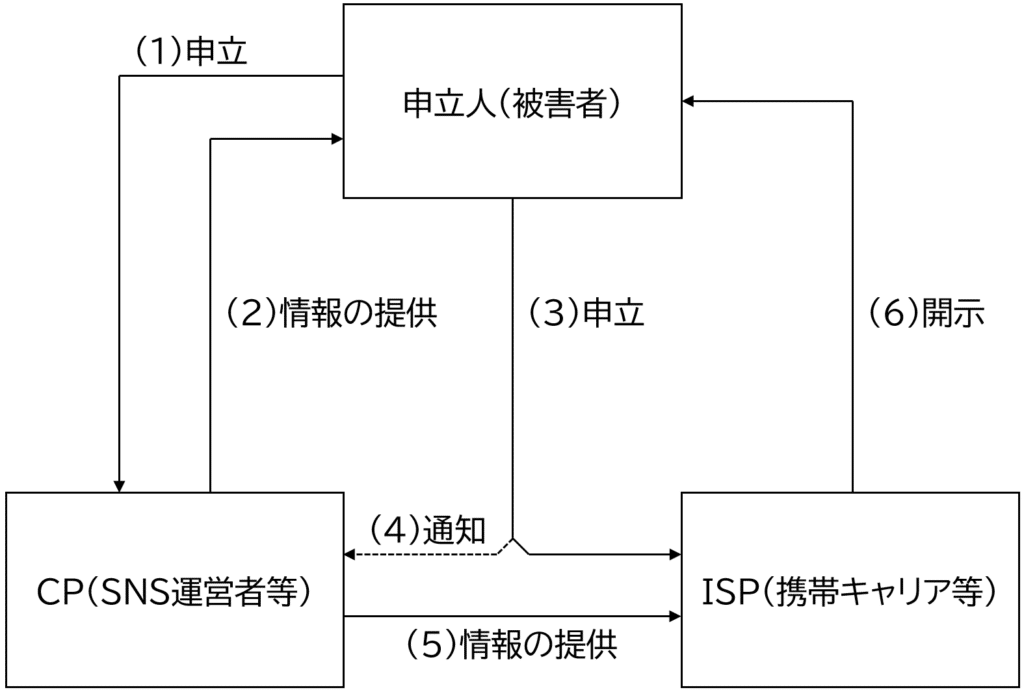Explanation of the 'Sender Information Disclosure Order Case' Started on October 1, 2022: Accelerated Poster Identification

On October 1, 2022, a new system called the “Sender Information Disclosure Order Case” was initiated as a procedure to identify the poster of defamation and rumor damage on the so-called Internet. In a nutshell, this was:
- A new system for disclosing names and addresses, which had previously been permitted only after multiple court procedures (provisional dispositions and trials).
- Using a system called “non-litigation case,” it was a new system to quickly realize disclosure with one procedure.
This was a system newly established by the amendment of the so-called Provider Liability Limitation Law, but what kind of procedure would it be specifically, and what changed compared to the past? I explained about the “Sender Information Disclosure Order Case.”
Overview and Issues of the Previous Poster Identification Procedure

Previously, the so-called poster identification procedure had a significant issue, particularly the time it required. This article omitted the details, but the overview was as follows:
Firstly, there were broadly two types of poster identification procedures.
The Method Started with an IP Address Disclosure Request
The first one was the case where the operator of the service where the defamatory or rumor-damage post had been made, such as an SNS operator (Content Provider, CP), did not hold the poster’s address or name information. For example, Twitter operators usually did not hold the poster’s address or name, and in the case of so-called anonymous bulletin boards, they definitely did not hold it. In such cases, the procedure was roughly as follows:
- First, a “provisional disposition,” a procedure that often ended in about a month, was initiated against the CP to request the disclosure of the poster’s IP address.
- From the IP address, the mobile carrier or other provider (Internet Service Provider, ISP) used by the poster was identified. Then, a “lawsuit,” a procedure that often took about half a year, was initiated against the ISP to request the disclosure of the poster’s address and name.
- Prior to this, negotiations or provisional disposition procedures were used to request the ISP to preserve the logs so that they did not disappear during the progress of the lawsuit.
This was the procedure. The main reason why a period of about half a year was required was due to the lawsuit part in step 2.
The Method That Started with a Request for Disclosure of Address, Name, or Phone Number
The second one was the case where the CP, such as a paid rental server, held the poster’s address, name information, or phone number. In this case, you could initially request the CP to disclose the address and name, but this procedure required a lawsuit. In other words,
- A lawsuit was initiated against the CP to request the disclosure of the poster’s address, name, or phone number.
- Prior to this, there might have been cases where it was necessary to request the CP to preserve the logs so that they did not disappear during the progress of the lawsuit, through negotiations or provisional disposition procedures.
- If the phone number was disclosed, a procedure called “Article 23 Inquiry” was used to request the mobile carrier, etc., to disclose the address and name.
This was the procedure. Ultimately, since part of it became a lawsuit, a period of about half a year was still required.
What Was the “Sender Information Disclosure Order Case” That Started on October 1, 2022?
The “Sender Information Disclosure Order Case” that started from October 1, 2022 had the following characteristics compared to the previous procedures:
- In the “first” case where the CP did not have address and name information, it was possible to disclose the address and name in one procedure.
- Because this “one-time procedure” was a “non-litigation case,” similar to a “provisional disposition,” the required period was shortened.
The general flow of the procedure was as shown in the figure below.

Filing for “Sender Information Disclosure Order” and “Provision Order”
First, the victim of slander and rumor damage filed for a “Sender Information Disclosure Order” and a “Provision Order” with the CP as the defendant. Even in cases where the CP did not have address and name information, such as Twitter or anonymous bulletin boards, it was always possible to file this because it was known who the CP was.
And, as with the previous procedure, if it was recognized that there was an infringement of honor rights or privacy rights, in short, “if the post was illegal,” this filing was accepted.
In detail, in the previous “provisional disposition,” disclosure was not allowed unless the requirement of “necessity of preservation” was recognized in addition to the illegality of the post. But in this filing, the “necessity of preservation” requirement was not necessary.
Provision of Information
If the filing was accepted, the CP provided the “name and other information of other disclosure-related service providers” to the applicant. In short, this was the information of the ISP, i.e., the business operator other than the CP, who was involved in the slanderous post.
In other words, from the standpoint of the applicant, if this provision was made, it became clear which ISP the post was made through, and it was almost the same as when the IP address disclosure provisional disposition was won in the “first” procedure.
Filing for “Sender Information Disclosure Order” and “Deletion Prohibition Order”
The applicant who received this information provision filed for a “Sender Information Disclosure Order” and a “Deletion Prohibition Order” with the ISP as the defendant within the same procedure.
This was:
- Sender Information Disclosure Order: Requested the ISP to disclose the poster’s address and name.
- Deletion Prohibition Order: Requested the ISP to preserve the log so that it did not disappear during the procedure.
These were the same as the lawsuit for address and name disclosure and the out-of-court negotiation or provisional disposition for log preservation in the “first” procedure, seeking the same effect.
Notification
At the same time, the applicant notified the CP that “I have filed for a Sender Information Disclosure Order against the ISP (also).”
Provision of Information
The CP, who received this notification, provided the poster’s IP address to the ISP. The ISP could identify the poster in the form of “Who was the user using IP address ●●.●●.●●.●● at ● year ● month ● day ● hour ● minute ● second?”, so at this point, it was internally understood “who was the poster of the slanderous post”.
In detail, at this point, the ISP conducted a so-called hearing with the poster. In other words, if, for example, the post was likely to be an infringement of honor rights, the ISP inquired and considered whether there were any circumstances that should deny the defamation, such as “The post appeared to be a baseless rumor, but the poster was criticizing based on evidence, so it was a legal post that did not constitute an infringement of honor rights”.
Disclosure of Address and Name
If the application for a Sender Information Disclosure Order against the ISP was accepted, the ISP disclosed the poster’s address and name to the applicant. In other words, at this point, the identification of the poster was realized.
In detail, at this point, the ISP notified the poster that “I have made a disclosure.”
Advantages of the Sender Information Disclosure Order Case

As mentioned above, the distinctive feature of the Sender Information Disclosure Order was that it could disclose the name and address of the poster within a single procedure. This was done through a relatively short-term procedure called a “non-litigation case,” rather than a lawsuit.
“Non-litigation case” might have been an unfamiliar term, but for instance, the initiation of guardianship and the approval of adoption had been handled as “non-litigation cases” for a long time. These procedures were adopted because they were not suitable for “litigation,” which was a time-consuming procedure.
How much time was actually needed for the procedure of the Sender Information Disclosure Order? There were still uncertainties in the practice after the start of this system, as it had not yet been initiated. However, it was said that the judgment of adult guardianship often ended within 1-2 months if the case was relatively simple. The Sender Information Disclosure Order might have required a slightly longer period compared to this. However, compared to the previous procedure, which usually took more than half a year, it was likely to end in about half the time, or a few months.
Summary: Identification of Posters through Sender Information Disclosure Orders Speeded up
As of the time of writing that article, the sender information disclosure order had not yet been initiated, and there were still unclear aspects in the finer details of its practice. As a law firm that handled a large number of reputation damage measures, including the identification of posters, we were particularly interested in how long it would realistically take to disclose names and addresses.
However, regardless, it was certain that the time it took for victims of reputational damage to identify the poster and claim damages, as well as prevent further damage, would be shorter than before. It could be said that this system should have been expected to be effectively utilized for the swift relief of victims.
Furthermore, not limited to sender information disclosure orders, when a new legal procedure that did not exist before was established, in reality, both lawyers and courts had no experience with the procedure at first, so there was a risk of problems arising in unexpected places. The response to such problems was based on deep knowledge and know-how in the relevant field. Especially for a while after the start of this system, there was a tendency that it might have been more efficient to request a law firm that had experience and know-how in reputation damage measures from the past.
Introduction to Our Firm’s Measures
Monolith Law Office is a legal office with high expertise in both IT, particularly the internet, and law. In recent years, overlooking information related to reputational damage and slander spread on the internet can lead to serious harm. Our firm provides solutions for managing reputational damage and online crises. Details are provided in the article below.
Category: Internet





















